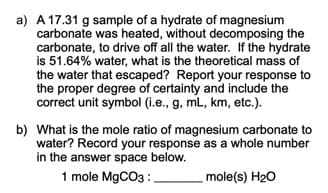a) A 17.31 g sample of a hydrate of magnesium carbonate was heated, without decomposing the carbonate, to drive off all the water. If the hydrate is 51.64% water, what is the theoretical mass of the water that escaped? Report your response to the proper degree of certainty and include the correct unit symbol (i.e., g, mL, km, etc.). b) What is the mole ratio of magnesium carbonate to water? Record your response as a whole number in the answer space below. 1 mole M9CO3 :. mole(s) H20
a) A 17.31 g sample of a hydrate of magnesium carbonate was heated, without decomposing the carbonate, to drive off all the water. If the hydrate is 51.64% water, what is the theoretical mass of the water that escaped? Report your response to the proper degree of certainty and include the correct unit symbol (i.e., g, mL, km, etc.). b) What is the mole ratio of magnesium carbonate to water? Record your response as a whole number in the answer space below. 1 mole M9CO3 :. mole(s) H20
Chemistry by OpenStax (2015-05-04)
1st Edition
ISBN:9781938168390
Author:Klaus Theopold, Richard H Langley, Paul Flowers, William R. Robinson, Mark Blaser
Publisher:Klaus Theopold, Richard H Langley, Paul Flowers, William R. Robinson, Mark Blaser
Chapter4: Stoichiometry Of Chemical Reactions
Section: Chapter Questions
Problem 58E: A mordant is a substance that combines with a dye to produce a stable fixed color in a dyed fabric....
Related questions
Question
I need help, please answer thank you!

Transcribed Image Text:a) A 17.31 g sample of a hydrate of magnesium
carbonate was heated, without decomposing the
carbonate, to drive off all the water. If the hydrate
is 51.64% water, what is the theoretical mass of
the water that escaped? Report your response to
the proper degree of certainty and include the
correct unit symbol (i.e., g, mL, km, etc.).
b) What is the mole ratio of magnesium carbonate to
water? Record your response as a whole number
in the answer space below.
1 mole M9CO3 :
mole(s) H20
Expert Solution
This question has been solved!
Explore an expertly crafted, step-by-step solution for a thorough understanding of key concepts.
This is a popular solution!
Trending now
This is a popular solution!
Step by step
Solved in 2 steps

Knowledge Booster
Learn more about
Need a deep-dive on the concept behind this application? Look no further. Learn more about this topic, chemistry and related others by exploring similar questions and additional content below.Recommended textbooks for you

Chemistry by OpenStax (2015-05-04)
Chemistry
ISBN:
9781938168390
Author:
Klaus Theopold, Richard H Langley, Paul Flowers, William R. Robinson, Mark Blaser
Publisher:
OpenStax

Chemistry: Principles and Reactions
Chemistry
ISBN:
9781305079373
Author:
William L. Masterton, Cecile N. Hurley
Publisher:
Cengage Learning

Introductory Chemistry: A Foundation
Chemistry
ISBN:
9781337399425
Author:
Steven S. Zumdahl, Donald J. DeCoste
Publisher:
Cengage Learning

Chemistry by OpenStax (2015-05-04)
Chemistry
ISBN:
9781938168390
Author:
Klaus Theopold, Richard H Langley, Paul Flowers, William R. Robinson, Mark Blaser
Publisher:
OpenStax

Chemistry: Principles and Reactions
Chemistry
ISBN:
9781305079373
Author:
William L. Masterton, Cecile N. Hurley
Publisher:
Cengage Learning

Introductory Chemistry: A Foundation
Chemistry
ISBN:
9781337399425
Author:
Steven S. Zumdahl, Donald J. DeCoste
Publisher:
Cengage Learning

Chemistry & Chemical Reactivity
Chemistry
ISBN:
9781337399074
Author:
John C. Kotz, Paul M. Treichel, John Townsend, David Treichel
Publisher:
Cengage Learning

Chemistry: Matter and Change
Chemistry
ISBN:
9780078746376
Author:
Dinah Zike, Laurel Dingrando, Nicholas Hainen, Cheryl Wistrom
Publisher:
Glencoe/McGraw-Hill School Pub Co
